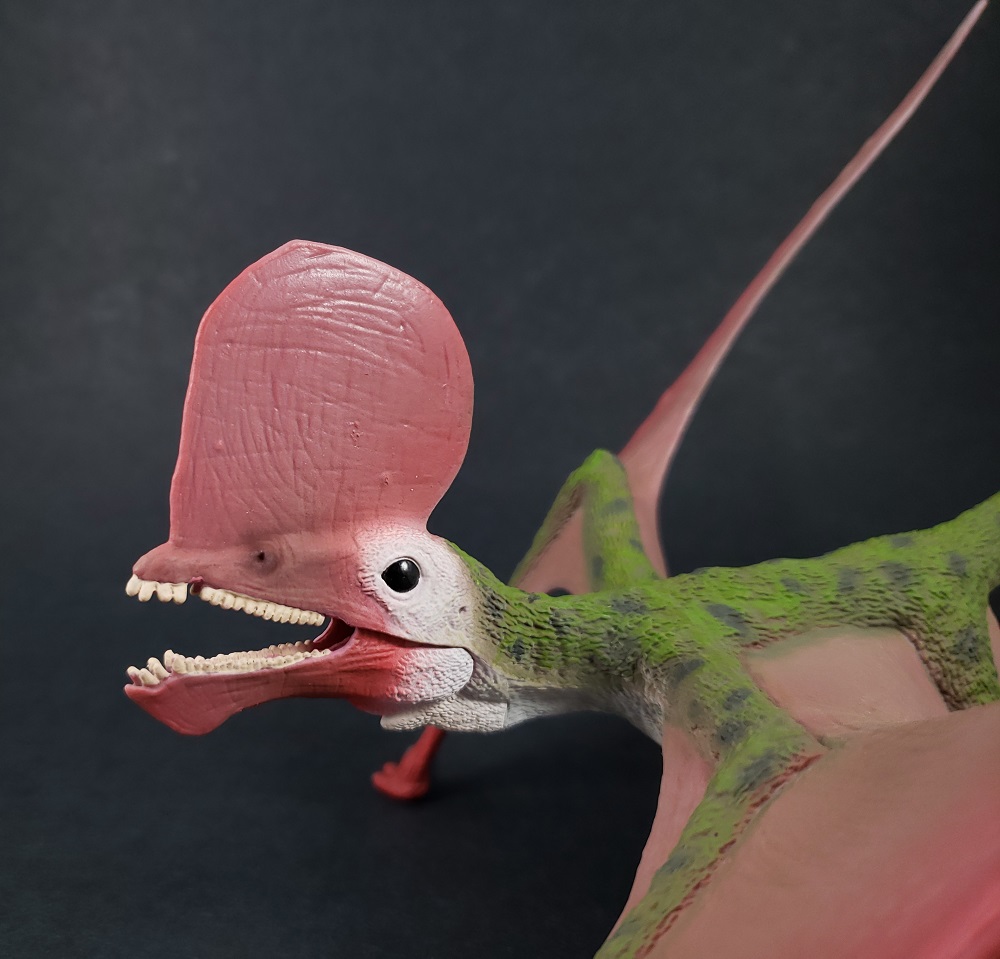
At this point I think it’s fair to say that a new large-format pterosaur is among the highlights of CollectA’s new figure announcements. They don’t quite come every year, but they do seem to be coming more frequently. This year’s choice was one of the earliest pterosaurs, the peculiar Caviramus schesaplanensis from the Rhaetian (Late Triassic) of what would become Eurasia.
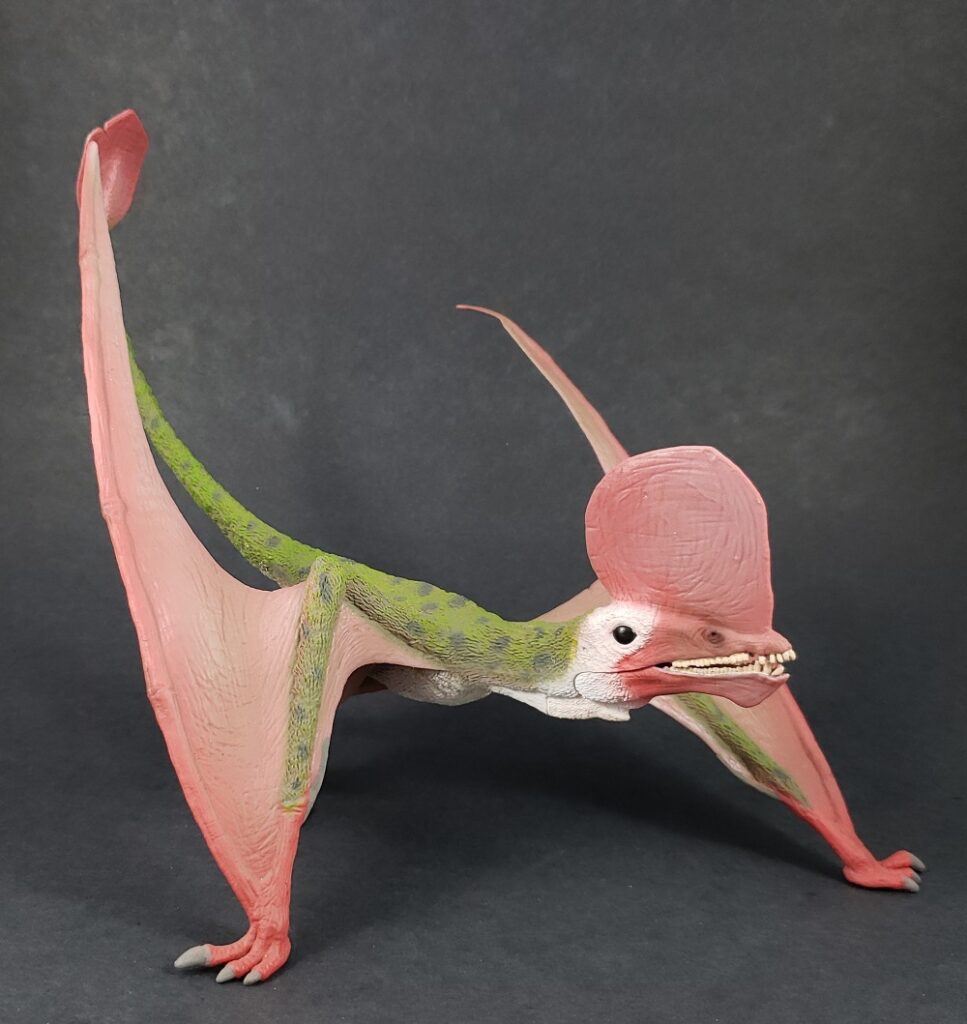
The first specimen of Caviramus was only a broken lower jaw which showed evidence of heavy teeth and an unusually low joint. Two years after this jaw, a more complete pterosaur specimen from the same formation in Switzerland was published and given the name Raeticodactylus filisurensis. It’s pretty likely that they are in fact the same species or very close relatives, and most depictions of Caviramus, including this one, are based on the more complete second specimen. It shows long wings, a robust skull with a large crest on top, and very distinctive teeth. Only a few pieces of the ribs, vertebrae, and hindlimb survive, but we can reasonably infer the animal’s general appearance based on relatives.
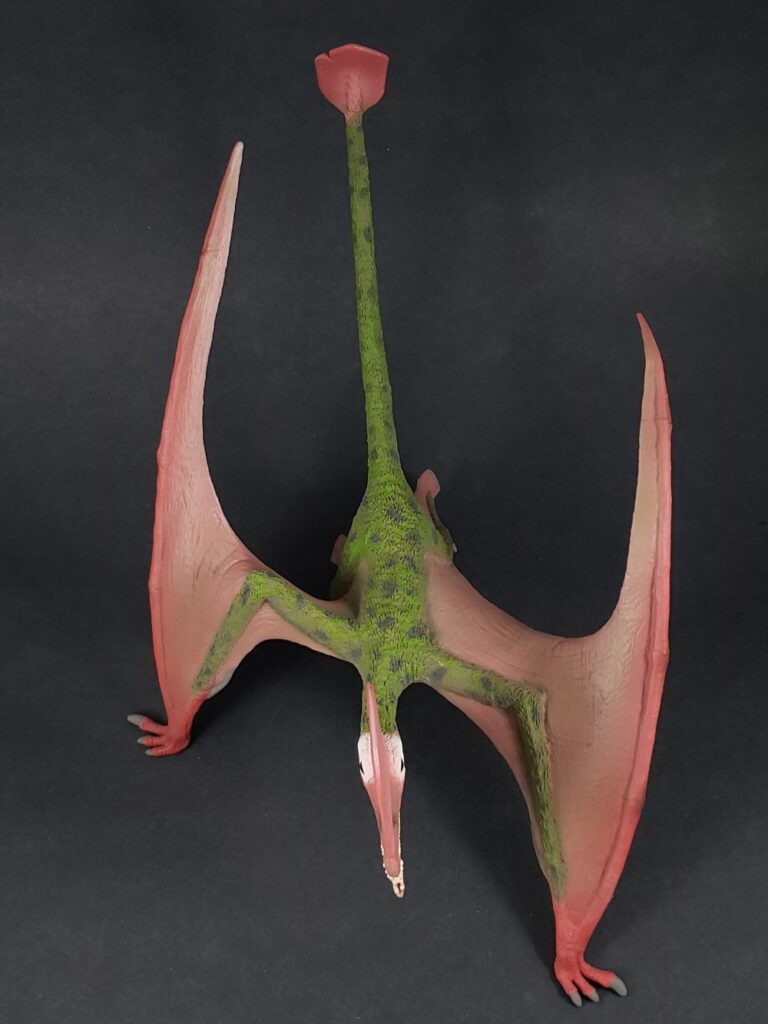
CollectA’s figure, sculpted by Matthias Geiger, is highly detailed and in an earthbound pose, as we’ve come to expect from their pterosaur figures. It’s sculpted in an active crouch, as though pursuing some ground-dwelling prey, perhaps an insect or crustacean. Its tail is held stiffly in the air, ready to deploy as a counterweight in a sudden turn. The vane of the tail has a small nick as from a healed injury, a welcome touch of personality. Based on fossil pterosaur footprints, it’s more likely that the hands were oriented with the finger pointing forward, rather than splayed to the side as shown here, but these trackways were only published this year, and Geiger couldn’t possibly have known about them when he sculpted this. The pose is visually interesting without being over the top.
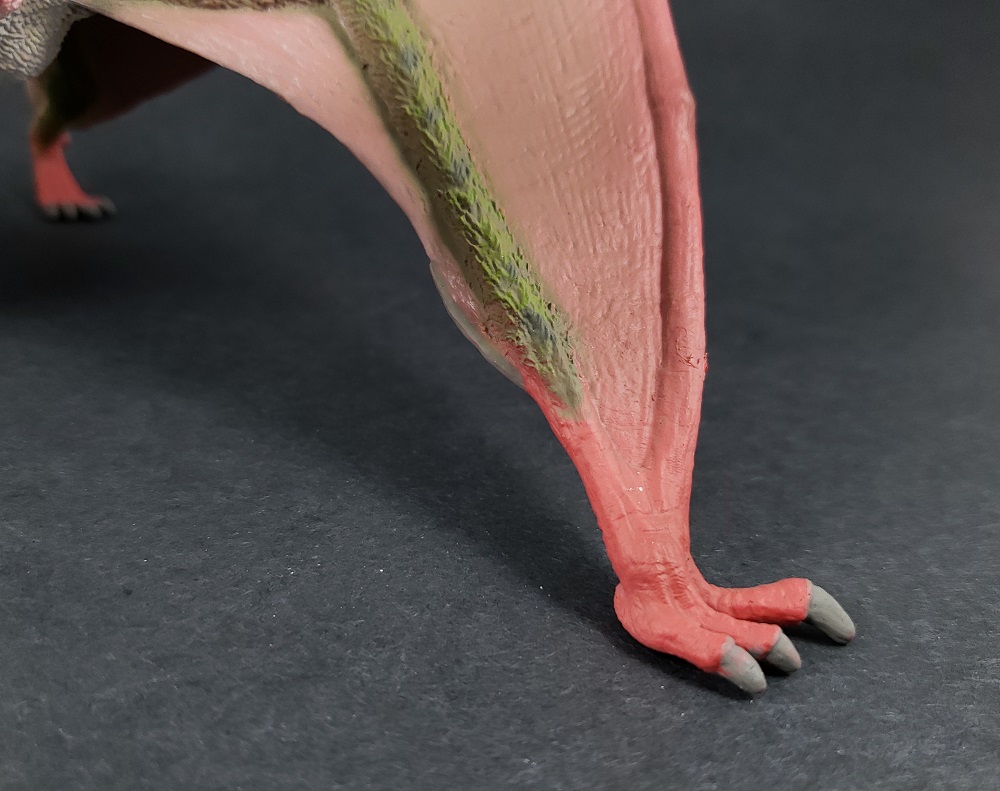
Based on an average of head and limb bone measurements, this figure is about 2/3 life size, a bit larger than the 1:2 scale it’s marketed as. The overall proportions based on those measurements are good, and the speculative parts of the anatomy seem reasonable. The wings look great, with the brachiopatagium (main membrane) giving an impression of dynamic tension as the animal gets ready to pounce. The figure has a complete uropatagium (tail membrane stretched between the ankles), with the horizontally vaned tail free. The brand and genus name are molded into the underside of the left wing.
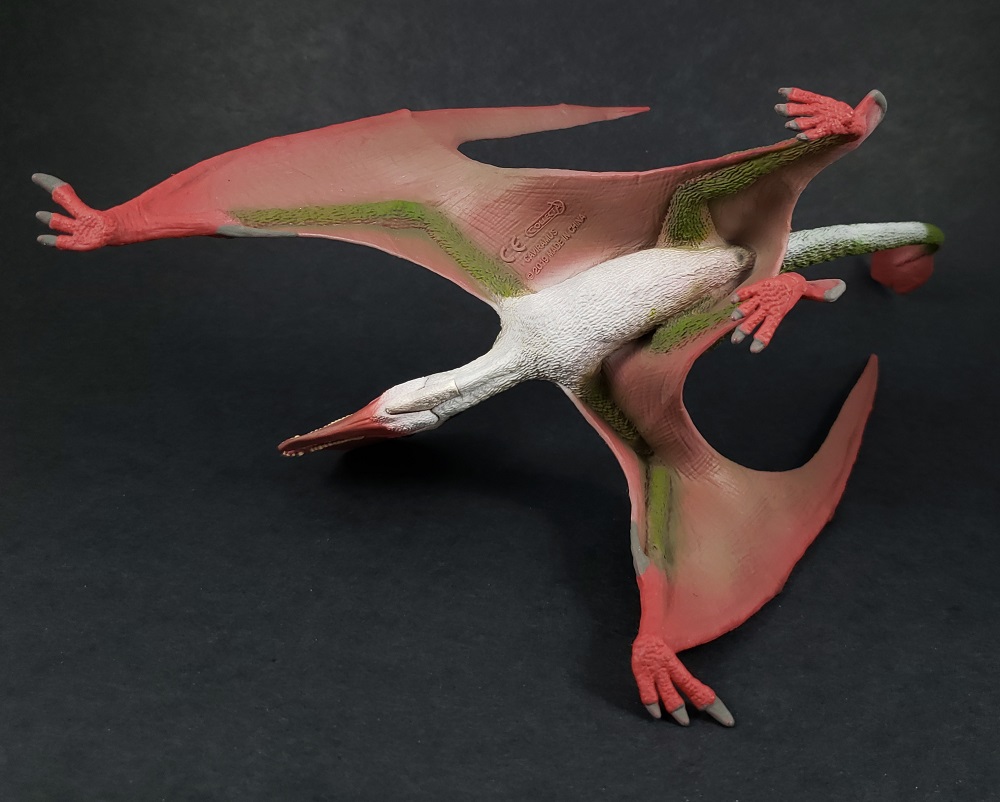
Our Caviramus sports an unusual color scheme. The skin and crest are salmon pink. A patch of white pycnofibers covers the face, throat, and belly. The rest of the body is covered in a mottled pelage of pine green and clayey brown, with irregular gray spots. The eye is a beady black, and the claws, pteroid, and distal fifth toe are all a matte gray. Dark washes decorate the nostrils and cloaca. Green in animal integument is usually the result of either structural color or a combination of structural color and pigment. We don’t know what colors pycnofibers could have come in, but if golden moles can have structurally iridescent fur, maybe pterosaurs could be green.
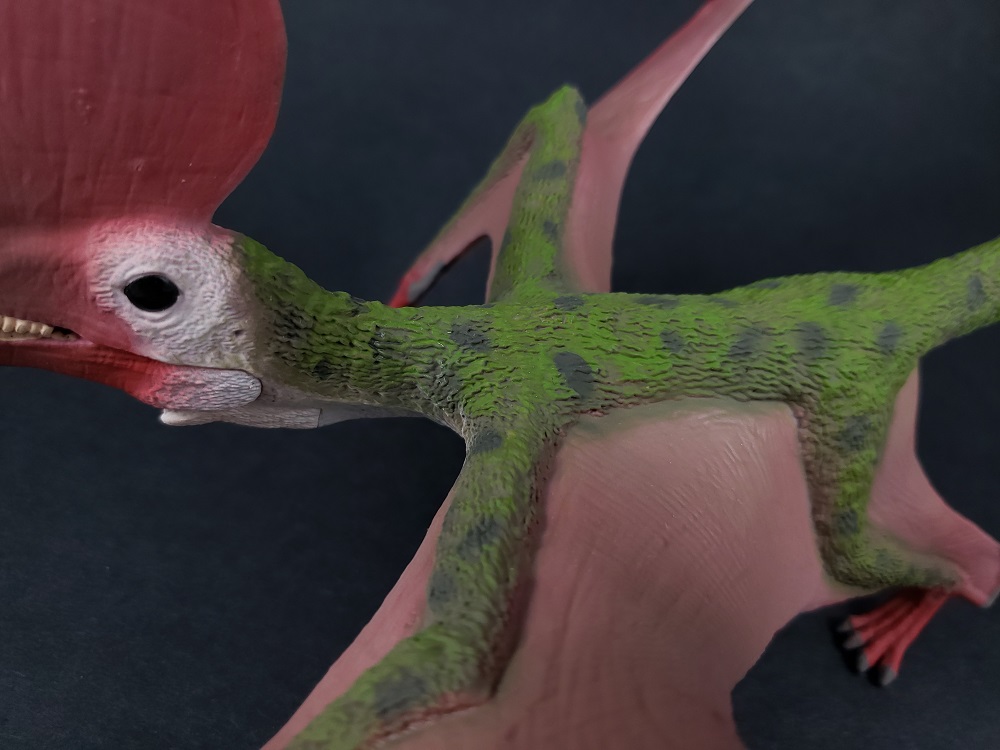
The head is well-sculpted, with the nostrils and ear openings in the right positions. The crest on the figure is considerably larger than the bony portion that was preserved as a fossil, closely resembling a reconstruction by Mark Witton. Other artists, like Andrey Atuchin, reconstruct it more conservatively. We don’t know how extensive the proteinaceous part of the crest was, but this seems like a reasonable hypothesis. The upper jaw has 4 pairs of large fangs and thirteen pairs of smaller teeth, and the lower jaw has 3 pairs of fangs and 20 pairs of smaller teeth behind, comporting with the restoration in the paper describing Raeticodactylus. The teeth of Caviramus were complex and multi-cusped, which isn’t evident on the figure but would be admittedly difficult to render at this scale. The teeth were clearly painted as a single unit, and there’s some tooth paint slopped onto the edges of the jaws. Inside the mouth, there’s also a bit of pink on the lingual sides of the teeth.
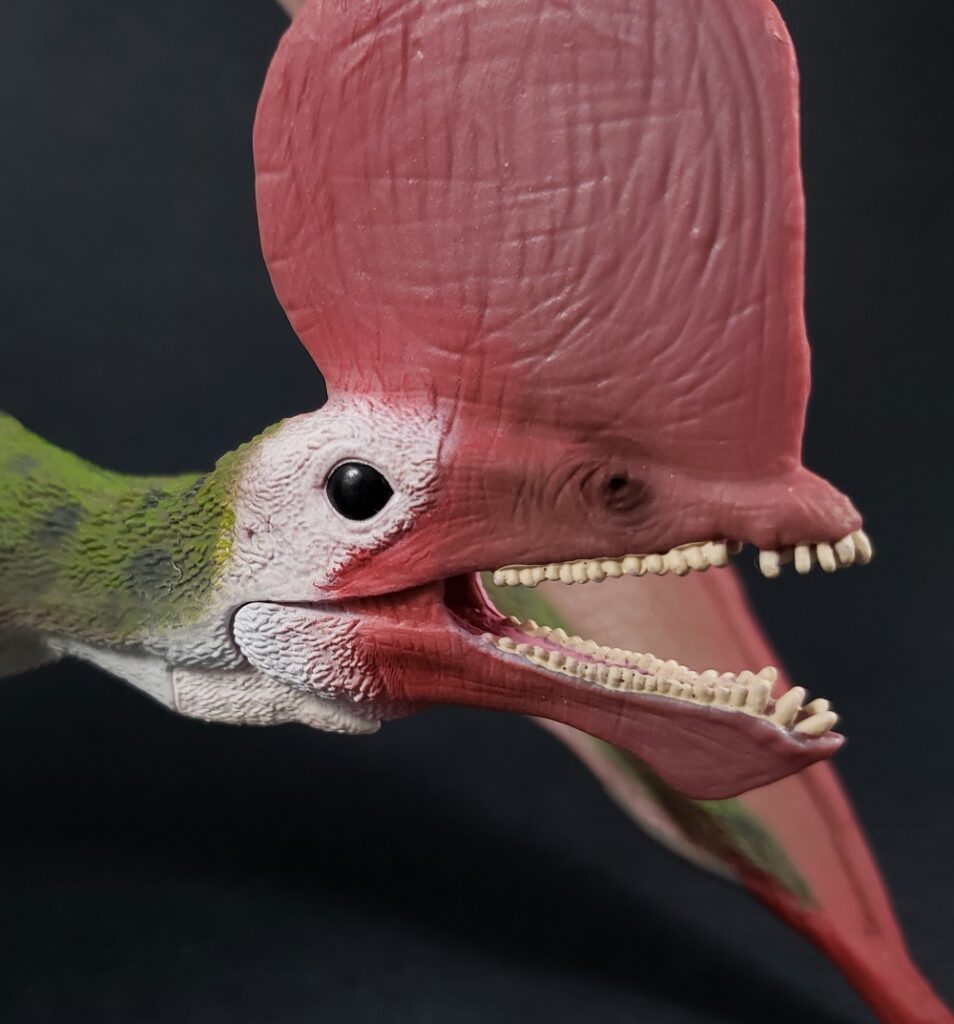
Caviramus was unusual in that it had a deep, heavy jaw, especially at the front and back. The joint was placed low at the back of the lower jaw, which allowed the teeth to meet each other all at once instead of a few at a time (more like a guillotine, less like a pair of scissors). The sculpt does a pretty good job capturing the contours, but the articulation of the jaw has its fulcrum just a bit too high. The throat has a sort of doorstop sculpted into it, restricting the range of motion of the jaw. When the jaw is closed, the doorstop is visible as an odd prominence like an Adam’s apple. The doorstop is also a separate piece, whose seam is visible farther back on the throat. It’s things like this that make me prefer figures without articulations, but if you leave the jaw open, it isn’t too obtrusive.

As I’ve established in previous reviews, the Triassic was hands-down the most interesting period of the Mesozoic. Caviramus is another example of the funky evolutionary side branches of the Triassic that gave us morphologies not quite seen thereafter. For most of their existence, CollectA has paid very little attention to the Triassic, but lately they’ve been making some really great forays into the period. This is another winner from that standpoint, and it’s well-executed to boot. Definitely recommended for both kids and adult enthusiasts.

Disclaimer: links to Ebay and Amazon on the DinoToyBlog are affiliate links, so we make a small commission if you use them. Thanks for supporting us!




Thanks for that thorough review.
I sure will add that great figure to my collection, but I`ll have to modify those weirdly blunted teeth and claws heavily before it goes on display. I hope CollectA goes back to former quality in this regard.
A most interesting and informative review, enhanced by excellent photos. I’m always delighted when CollectA releases one of their Supreme pterosaurs. This one was worth the wait. I don’t find the colour choice to my personal taste but I commissioned a repaint.
Good descriptive article about that great caviramus figure, although I honestly would have liked a different repaint from the one Collecta did. I would have liked a paint tone like its counterpart the guidraco. The caviramus paint is the only thing that doesn’t convince me, I repeat.
It’s definitely unconventional, but in-hand it’s grown on me.
Great review. I absolutely adore this sucker, just like all the previous Supreme pterosaurs. Really hoping CollectA tackles Jeholopterus or Anurognathus next.
Thanks! An anurognathid would definitely be cool at this scale
Wonderful review of this fabulous figure. It really is a cool figure, and I found that the more I look at it, the more I love it. The colors grew on me.
There is also something very unnervingly creepy about it that makes it cool!
Thanks very much! I had the same experience with the paint scheme. I think the overall creepiness owes a lot to the beady eyes.
Also, the pose is very dragon-like; it reminds me of Smaug or Drogon.